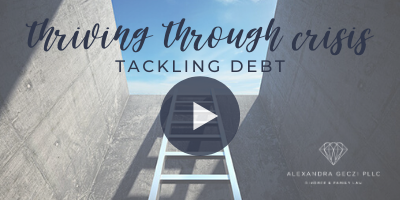If you want to improve your life, having good credit is fundamental. Having good credit will get you approved for better places to live, better interest rates on loans and credit when you need it. Good credit will help you achieve your financial goals. However, when you are drowning in debt, having good credit can feel like a fairy tale.
This blog will set out the steps you can take today to begin tackling debt so that good credit becomes reality, even in times of crisis.
First, it is important for you to closely review your credit regularly. Credit monitoring websites and apps abound; some charge fees and others don’t. Some big names in the business include Credit Karma and Mint, but many of the big banks have them too, like Capital One.
At a minimum, you should pull your credit report once a year from each of the three major credit reporting agencies at www.annualcreditreport.com. That is the only site that the U.S. government approves, and every American is entitled to a free credit report from that site each year. It is an easy, free resource, so use it.
Once you have pulled your credit report, review it to check for errors and outstanding debts. If you find errors, be sure to follow the instructions on the report on how to dispute those errors.
You can also consider working with third parties to repair your credit. But before you do, keep in mind that there are a lot of scammers out there. Do your research and understand what you want and what you are getting. Read the fine print.
To help, here are some common definitions of terms you may encounter:
Debt consolidation – an effort to combine debts from several creditors, then taking out a single loan to pay them all, hopefully at a reduced interest rate and lower monthly payment
Debt settlement – negotiating with creditors to settle a debt for less than what is owed.
TIP: The pros and cons of debt settlement and debt consolidation vary, especially with regard to the amount of time it will take to eliminate debts and the impact it will have on your credit score. Both aim to make your debt more manageable. When used properly, either can help you get out of debt sooner and save money.
Debt management – a strategic effort to eliminate unsecured debt like credit cards and medical bills. It’s not a loan but a program that educates you about your debt and teaches you how to manage it.
TIP: In a typical program, debt management companies work with creditors on your behalf to reduce your monthly payment and interest rates on your debt and waive or reduce any penalties. The parties agree on an affordable payment schedule that allows 3-to-5 years to pay off your debt. A debt management plan is part of the package of debt consolidation plans that are designed to help people regain control of their finances while reducing unsecured debts.
Credit repair – a process of fixing poor credit standing that may have deteriorated for a variety of different reasons. Repairing credit standing may be as simple as disputing mistaken information with the credit agencies. Identity theft, and the damage incurred, may require extensive credit repair work. Click here for more information on improving and repairing credit.
Bankruptcy – legal process that forgives debt.
TIP: There are several types of bankruptcy, but the two most popular ones are Chapter 7 and Chapter 13. In Chapter 7, certain assets are considered exempt — home, automobile, retirement savings, some tools and some home furnishings — but all others are liquidated and the funds used to pay your creditors. Chapter 13 bankruptcy gives you a chance to reorganize your finances and come up with a plan to repay all or most of your debt in a time frame of 3–5 years.
Unlike debt settlement and debt consolidation, bankruptcy typically wipes out all unsecured debt. Although this may seem like a solution to your money problems, it will have lasting consequences on your credit report. Bankruptcy remains on your credit report for up to 10 years.
Unsecured debt – An unsecured debt is one that is not backed by collateral, and includes credit cards, medical bills and student loans.
Secured debt – backed by collateral, like a mortgage or car financing.
There are a lot of options out there with different pros/cons and potential scammers. You should seriously consider working with a financial planner or personal finance expert to figure out which option is best for you. They can be a great resource in helping you create a debt payment plan, budget, and financial goals.
Now, let’s dive into some specific strategies you can use to pay down debt, even during COVID-19 and the coronavirus pandemic.
To learn specific debt reduction strategies and debt elimination resources, click below to watch the video.

